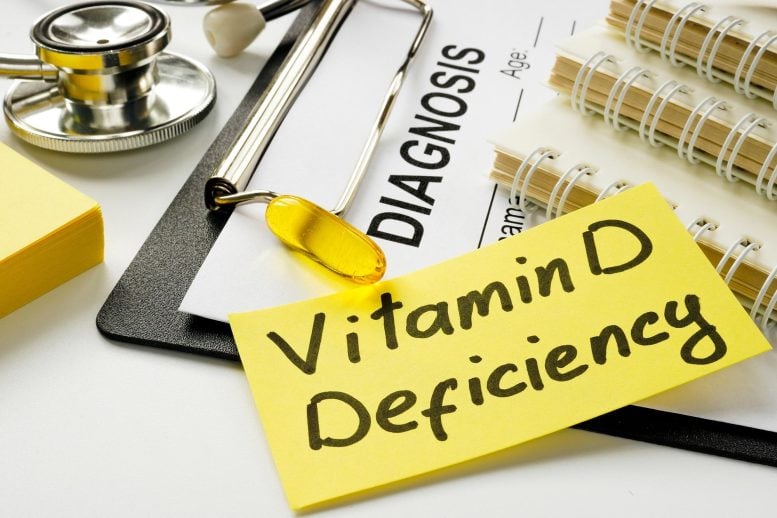
The new Clinical Practice Guideline by the Endocrine Society recommends against excessive vitamin D supplementation in healthy adults under 75 and unnecessary testing for vitamin D levels. It advocates higher vitamin D intake for children, the elderly over 75, pregnant individuals, and adults with prediabetes.
New Endocrine Society Guideline recommends vitamin D higher than the recommended daily allowance for children, pregnant people, adults over 75, and adults with prediabetes.
Healthy adults under the age of 75 are unlikely to benefit from taking more than the daily intake of vitamin D recommended by the Institutes of Medicine (IOM) and do not require testing for vitamin D levels, according to a new Clinical Practice Guideline issued today by the Endocrine Society. For children, pregnant people, adults older than 75 years and adults with high-risk prediabetes, the guideline recommends vitamin D higher than the IOM recommended daily allowance.
The Debate Over Vitamin D
Vitamin D use and blood vitamin D levels have been associated with many common diseases. However, whether vitamin D supplementation lowers the risk of these diseases and what vitamin D blood levels are needed for better health have been debated for years.
In this new guideline, the panel of experts established guidelines for vitamin D use and testing for vitamin D levels in healthy persons without established indications for vitamin D treatment or testing. The guideline relied on clinical trials to develop the recommendations.
Publication and Purpose of the Guideline
The guideline, titled “Vitamin D for the Prevention of Disease: An Endocrine Society Clinical Practice Guideline,” was published online and will appear in the August 2024 print issue of The Journal of Clinical Endocrinology & Metabolism (JCEM), a publication of the Endocrine Society.
“The goal of this guideline was to address the vitamin D requirements for disease prevention in a generally healthy population with no underlying conditions that would put them at risk of impaired vitamin D absorption or action,” said Marie Demay, M.D., of Harvard Medical School and Massachusetts General Hospital in Boston, Mass. Demay is the chair of the panel that developed the guideline. “Healthy populations who may benefit from higher dose vitamin D supplements are those 75 and older, pregnant people, adults with prediabetes, and children and adolescents 18 and younger, but we do not recommend routine testing for vitamin D levels in any of these groups.”
Key Recommendations
The guideline’s key recommendations include:
- We suggest against vitamin D supplements at doses beyond the reference dietary intakes recommended by the IOM in healthy adults under 75 years old.
- We identified the following populations that may benefit from supplementation above the intakes recommended by the IOM because of the potential to reduce specific health risks:
- Children and adolescents 18 and younger—potential to prevent nutritional rickets and to reduce the chance of respiratory infections.
- Individuals 75 and older—potential to lower mortality risk.
- Pregnant people—potential to reduce risk of pre-eclampsia, intra-uterine mortality, preterm birth, small-for-gestational age birth and neonatal mortality.
- People with prediabetes—potential to reduce progression to diabetes.
- In adults ages 50 years and older who have indications for vitamin D supplementation or treatment, we suggest daily, lower-dose vitamin D instead of non-daily, higher-dose vitamin D.
- We suggest against routine testing for 25-hydroxyvitamin D levels in any of the populations studied, since outcome-specific benefits based on these levels have not been identified. This includes 25-hydroxyvitamin D screening in people with dark complexion or obesity.
Limitations of Current Evidence
Even though the evidence on the role of vitamin D in health and disease has increased over the last decade, the panel noted many limitations in the available evidence. For example, many of the large clinical trials were not designed for several of the outcomes that they reported, and the studied populations had vitamin D blood levels that most would consider adequate to begin with. Based on insufficient evidence, the panel could not determine specific blood-level thresholds for 25-hydroxyvitamin D for adequacy or for target levels for disease prevention.
Reference: “Vitamin D for the Prevention of Disease: An Endocrine Society Clinical Practice Guideline” by Marie B Demay, Anastassios G Pittas, Daniel D Bikle, Dima L Diab, Mairead E Kiely, Marise Lazaretti-Castro, Paul Lips, Deborah M Mitchell, M Hassan Murad, Shelley Powers, Sudhaker D Rao, Robert Scragg, John A Tayek, Amy M Valent, Judith M E Walsh and Christopher R McCartney, 3 June 2024, The Journal of Clinical Endocrinology & Metabolism.
DOI: 10.1210/clinem/dgae290
Other members of the Endocrine Society writing committee that developed this guideline include: Anastassios Pittas (co-chair) of Tufts Medical Center in Boston, Mass.; Daniel Bikle of the University of California San Francisco in San Francisco, Calif.; Dima Diab of the University of Cincinnati in Cincinnati, Ohio; Mairead Kiely of University College Cork in Cork, Ireland; Marise Lazaretti-Castro of Universidade Federal de Sao Paulo in Sao Paulo, Brazil; Paul Lips of Amsterdam University Medical Center in Amsterdam, Netherlands; Deborah Mitchell of Massachusetts General Hospital and Harvard Medical School in Boston, Mass.; M. Hassan Murad of the Mayo Clinic in Rochester, Minn.; Shelley Powers of American Bone Health in Raleigh, N.C.; Sudhaker Rao of Henry Ford Health in Detroit, Mich. and Michigan State University in Lansing, Mich.; Robert Scragg of The University of Auckland in Auckland, New Zealand; John Tayek of Harbor-University of California Los Angeles Medical Center in Torrance, Calif.; Amy Valent of Oregon Health & Science University in Portland, Ore.; Judith Walsh of the University of California San Francisco in San Francisco, Calif.; and Christopher McCartney of the University of Virginia in Charlottesville, Va., and West Virginia University in Morgantown, W.Va.
The guideline was developed using a rigorous methodology that incorporates numerous improvements initiated in 2019. The individuals leading our guideline development panels are not permitted to have any relevant conflicts of interest, and more than half of the writing group members must be free of any relevant conflicts.
The Society established its Clinical Practice Guideline Program to provide endocrinologists and other clinicians with evidence-based recommendations in the diagnosis, treatment, and management of endocrine-related conditions. Each guideline is developed by a multidisciplinary panel of topic-related experts in the field. Guideline development panels rely on evidence-based reviews of the literature in the development of guideline recommendations. The Endocrine Society does not solicit or accept corporate support for its guidelines. All Clinical Practice Guidelines are supported entirely by Society funds.
This Clinical Practice Guideline was co-sponsored by the American Association of Clinical Endocrinologists, the European Society of Endocrinology, the Pediatric Endocrine Society, the American Society for Bone and Mineral Research, the Vitamin D Workshop, the American Society of Nutrition, the Brazilian Society of Endocrinology and Metabolism, the Society of General Internal Medicine, and the Endocrine Society of India.









WHAT IS the IOM recommended daily allowances?
I see no mention of that.
Kind of important for this article, don’t you think?
Bla Bla Bla Bla Bla! What is the RDA?
Headline should be, “This article won’t tell you the amount of Vitamin D you should have.”
Not of any use.
This article actually de-informs people for reasons known only to the sponsers.
You undermine your credibility when you use terms like “pregnant people”. The correct term, as everyone knows, is “pregnant women”.
Pregnant people? You mean women?
“Pregnant people”? You mean women.
If you can’t figure out what a woman is, why should anybody pay attention to anything else you say?
As Usual, there’s no information on the roll of vitamin K2 nor the need for D3 as opposed to D2. Who paid for the study?
During the Covid virus outbreak, I started taking 4000 IU of D3 each day. I managed to avoid the virus for 2 years, and was able to get a vaccine, and 2 boosters when I finally came down with the real thing. It wasn’t that bad, and the infection was over and done in 4 days, bit bad. I attribute this to the large doses of D3 I was taking. However, I began to get a lot of tingling in my hands. I read that this could be a sign of too much D3, so I stopped taking D3 for a few weeks. The tingling in my hands went away. I then went back to 1000IU of D3, once a week. I think D3 did work for me, but I did managed to get my D3 levels way up to a point where it was causing problems it’s self. Rolling back to 1000IU seems to be a good compromise.
There is some differing opinion from the UK, where some appear to know what they are talking about.
https://youtu.be/gM2CIbzWmUQ?si=gbn0Jl70qjhsqfyf
70% of people are short of viamin D?
Tests are done on persons without lack vitamin D. Supplementation of vitamin D proved no benefit. Therefore it is recommended not to take extra vitamin D if you are short of vitamin D
Also no mention of vitamin K2 to make Vitamin D effective. This is a seriously faulty report by an incompetent “commission”